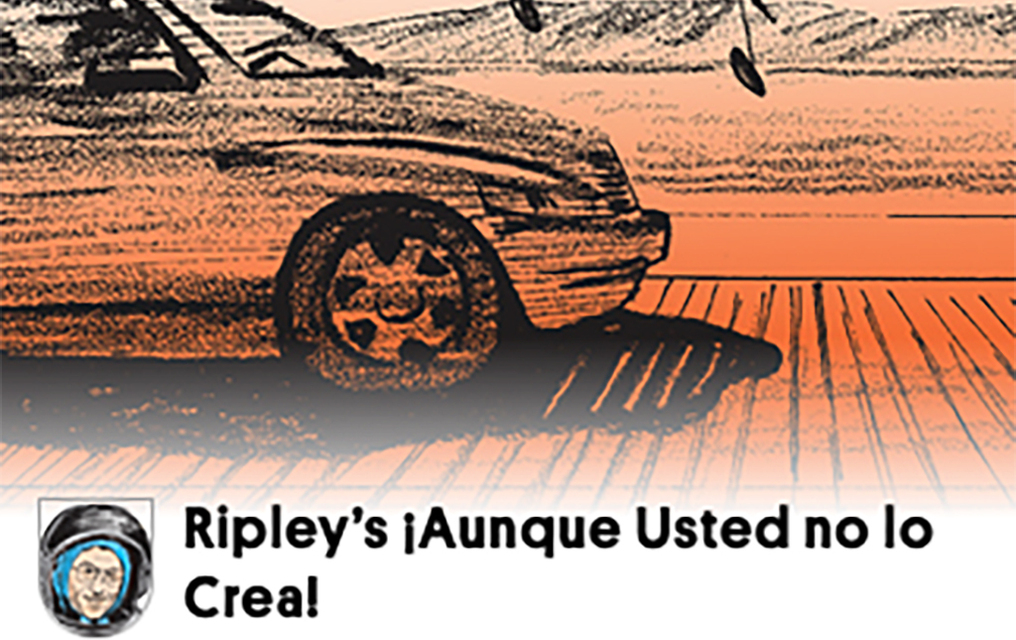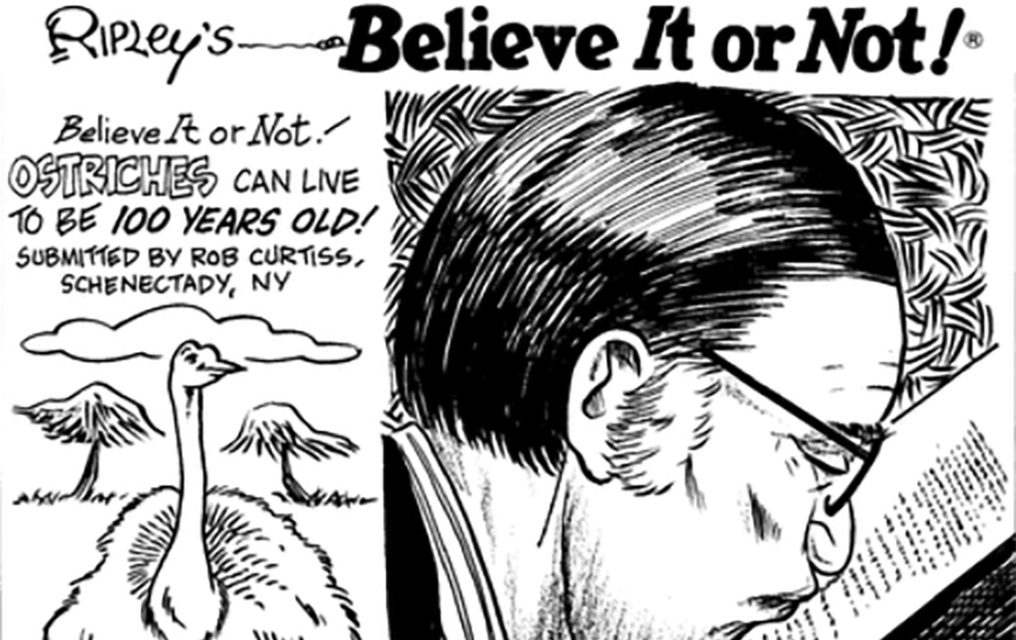Ripley's Believe It or Not by Ripley’s Believe It or Not! for August 18, 2014
Transcript:
A piece of the apple tree that inspired Sir Isaac Newton's discovery of gravity traveled into space aboard the Space Shuttle Atlantis in 2010. Physicists at Harvard have slowed the speed of light to less than the top speed of a racehorse using super low temperatures. Scholars in medieval Baghdad who translated books into Arabic received the weight of the book in gold as a reward.






Templo S.U.D. over 10 years ago
Uh… how was that piece of Isaac’s tree stay well preserved after all these years without rot or termites?
hawgowar over 10 years ago
Then, in interstellar space where it’s like, almost absolute zero, as cold as you can get, light only travels at about 50 MPH? LOL Maybe the stars are much closer than we think. If that were so, then a light year would be less than 450,000 miles. That puts Alpha Centauri a mere 1.8 million miles away, or less than 3 days by Apollo spacecraft.
johnt204 over 10 years ago
Books in old Baghdad must’ve gotten a lot of embellishments to their stories or histories. Or maybe just LARGE PRINT.
Sidhekin over 10 years ago
The speed of light in a non-vacuum medium is not constant, though. These Harvard physicists have used a dense (at least as compared to interstellar space) as well as cold medium. The stars remain distant.
Ikemeister over 10 years ago
@Wai Ng @hawgowarhttp://news.harvard.edu/gazette/1999/02.18/light.html
Mneedle over 10 years ago
As to the hunk of tree and the speed of slow light, I have but one question: Why?
Fan o’ Lio. over 10 years ago
Even at 40mph it doesn’t take long for that beam of “light” to get from one end of the test tube to the other.
Bob. over 10 years ago
Now when my boss asks why I took so long, I;ll just say I came at the speed of light, but it was cold outside.
markzwaan over 10 years ago
THis was done by Lene Vestergaard Hau in 1999. She was even able to stop light completely. Something which could be used to recreate and study the properties of black holes.@Eirik Hanssen That’s correct, they created what is called a “Bose-Einstein Condensate”. Which is millions upon millions of atoms behaving like one super atom. They need to cool these atoms to almost 0 degrees Kelvin in order to achieve this.
markzwaan over 10 years ago
From Dirk Gently by Douglas Adam:
“Sir Isaac Newton, renowned inventor of the milled-edge coin and the cat-flap!"
“The what?” said Richard.
“The cat-flap! A device of the utmost cunning, perspicuity and invention. It is a door within a door, you see, a …”
“Yes,” said Richard, “there was also the small matter of gravity.”
“Gravity,” said Dirk with a slightly dismissed shrug, “yes, there was that as well, I suppose. Though that, of course, was merely a discovery. It was there to be discovered.” … “You see?” he said dropping his cigarette butt, "They even keep it on at weekends. Someone was bound to notice sooner or later. But the cat-flap … ah, there is a very different matter. Invention, pure creative invention. It is a door within a door, you see.”
english.ann over 10 years ago
I thought all books in medieval times were scrolls, that we didn’t invent movable print until the sixteenth century with Johann Gutenberg. Books were all previously written by hand (translated, too); I imagine translators in medieval Baghdad wrote on papyrus.
Space_cat over 10 years ago
The shortest book in the world is “The History of Arab Iconography”.
fixer1967 over 10 years ago
On the speed of light thing, they cheated. They made a clear chemical goo and then froze it solid. Then they shoot a laser thought it. In short it was about like shinning a flashlight thought a cement block.
tlynnch over 10 years ago
How did they verify that is was a good translation?
John W Kennedy Premium Member over 10 years ago
Christians used codices (singular: codex; meaning: the kind of book with pages fastened together at the edge) almost from the beginning. By the middle ages, no one was using scrolls in the west except Jews. But I don’t know about Arabs.
It takes a lot less to verify that something is an OK translation than it does to create one. The one requires expertise in the source language and competence in the target language. The other requires expertise in both languages and literary talent, to boot.
MetalOverCountry about 10 years ago
NASA sure is bored.